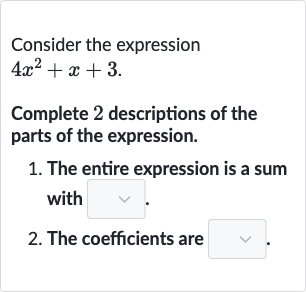Full solution
Q. Consider the expressionComplete descriptions of the parts of the expression.. The entire expression is a sum with .. The coefficients are .
- Polynomial Standard Form: The expression is a polynomial in standard form. The standard form of a polynomial is when the terms are ordered from the highest degree to the lowest degree. In this case, the term with the highest degree is , followed by , and then the constant term .
- Sum of Terms: The entire expression is a sum of three terms: , , and . Each term is added together to form the polynomial.
- Coefficients Explanation: The coefficients in a polynomial are the numerical factors that multiply the variable terms. In the expression , the coefficient of the term is , the coefficient of the term is (since any number multiplied by is itself, the coefficient is implied), and the constant term can also be considered a coefficient, specifically of the term or .
More problems from Factor using a quadratic pattern
QuestionGet tutor help
QuestionGet tutor help

